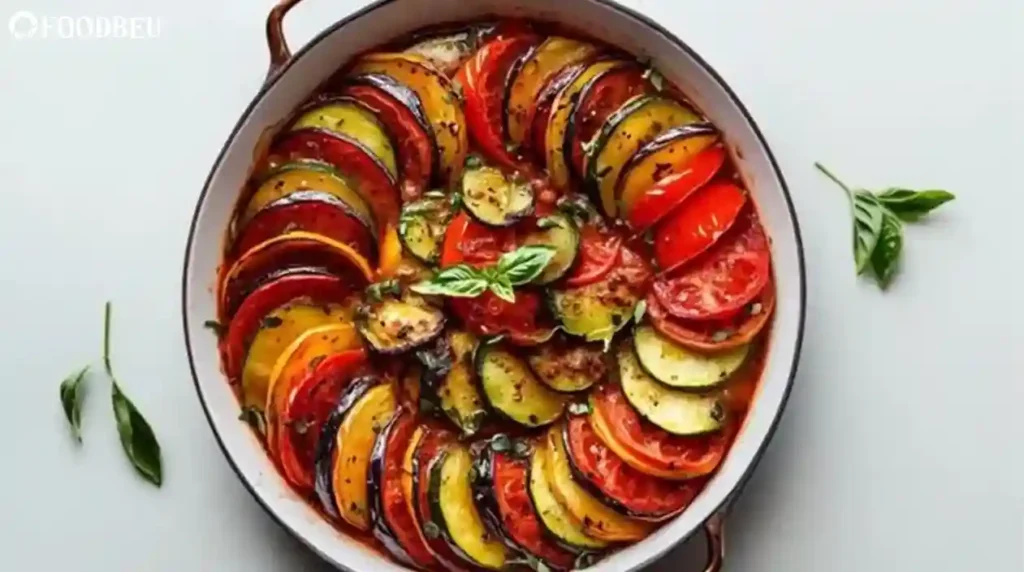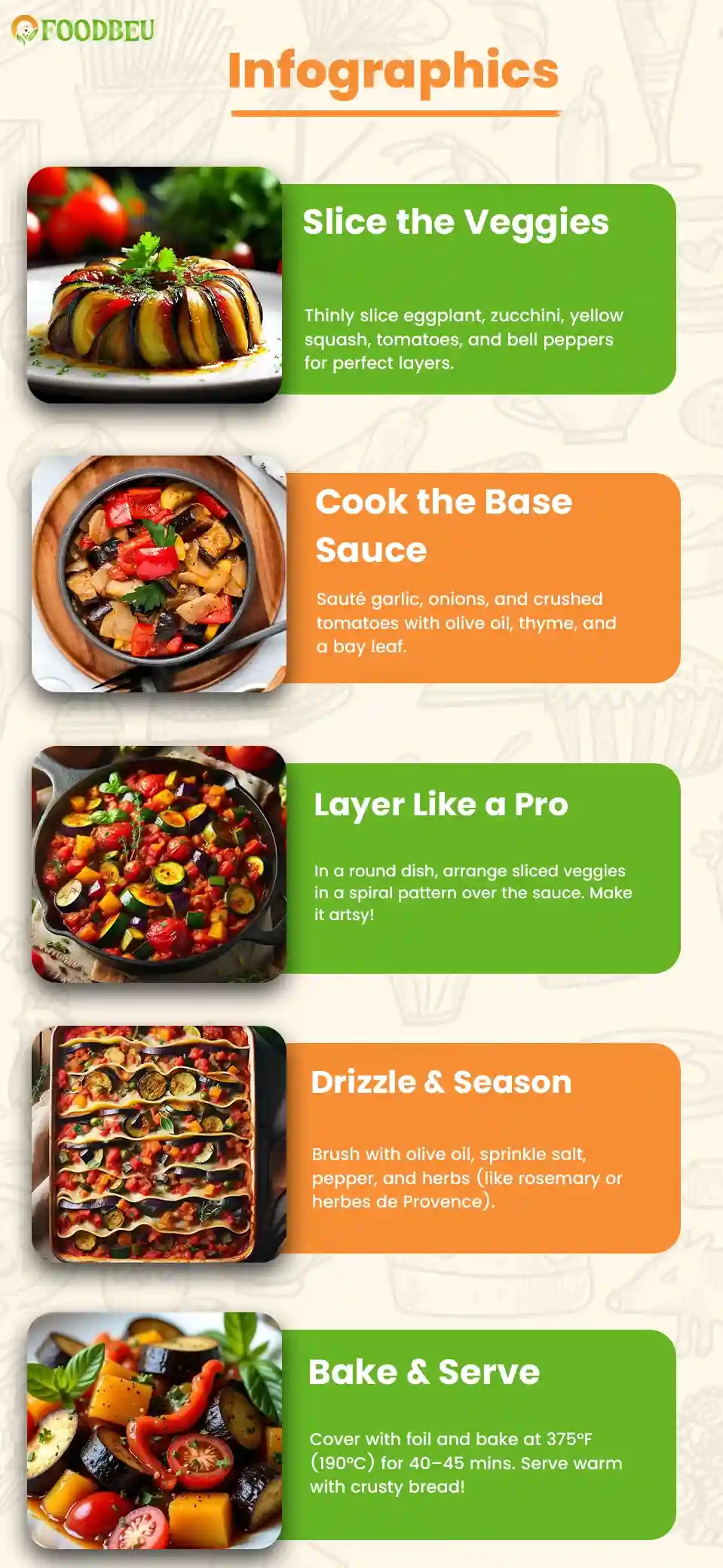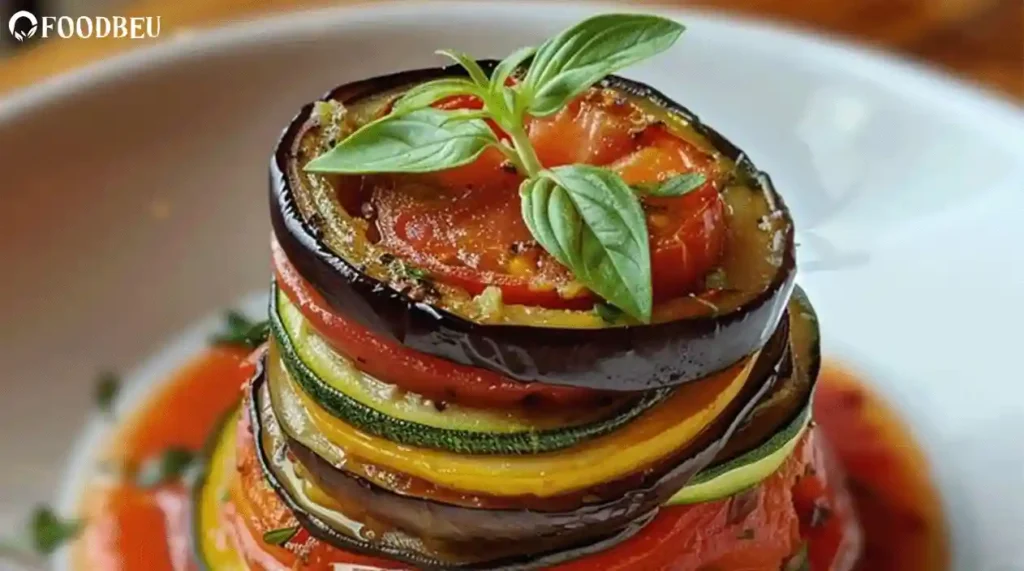Ratatouille is one of those dishes that checks every box. Comforting? Yes. Flavor-packed? Absolutely. Flexible? You bet. Our today’s ratatouille recipe pulls straight from tradition, where rustic cooking meets pure flavors, and enhances it by treating each vegetable the way it deserves: i.e, with a hot pan, some patience, and just the right amount of seasoning.
So, anyone thinking in their head on how to cook ratatouille, this isn’t just about mixing some veggies in a pot; it’s a slow-building kind of flavor. One that builds its way up from charred eggplant and sweet onions to a rich tomato base that carries the dish to the finish line. You could be new to ratatouille recipes, or you may be looking for the best ratatouille recipe to save and repeat; this is the one to keep.
History of the Dish
Ratatouille didn’t start as a chef’s masterpiece. It began as peasant food. It was made by farmers in the South of France, mostly around Nice city, and this dish was originally a way to utilize the summer vegetables before they spoiled. It was rustic. No frills. No spiral cuts or perfectly plated servings. Just good, honest food cooked slowly over heat.
The name itself comes from the French verbs “rata” (a chunky stew) and “touiller” (to stir). And this explains is basically what it was back in those times, i.e, a quick stirred-up stew of whatever vegetables were available. With the passage of time, the dish found its proper identity around the world: eggplant, zucchini, peppers, tomatoes, onion, garlic, and herbs.
While many people associate it with fine-dining or animated movies now (thanks to ratatouille’s ratatouille recipe from the film), its roots are very humble. Its flavor? Everything.
What started in clay pots over open fires now lands on tables in Michelin-starred restaurants. But the soul of it? Still the same.
Visit: How to Cook Tofu – Crispy Air Fryer & Pan-Fried Vegan Recipes
What Does Ratatouille Taste Like?
The flavor hits in layers. First, that silky eggplant, smoky, almost meaty, slides in. Then come the onions, sweet from caramelization, soft like velvet. Zucchini snaps in fresh and clean. Tomatoes? Bright, a little tangy, anchoring everything without overwhelming.
And then bell peppers are punchy, vibrant, cut through like a sudden breeze in July.
Add herbs: thyme for depth, parsley for lift. Garlic whispers sharpness. A dash of sugar? Just enough to quiet the acid.
So, what does ratatouille taste like? Earthy. Sweet. Sharp. Clean. Like summer, cooked slow and served warm.

The Best Ingredients for Ratatouille
When you’re choosing your ingredients, be very cunning about it; go for fresh, in-season produce. Ratatouille can be made with whatever is around, but if you want a classic take, these, in their fresh form, are your go-tos:
- Eggplant: Firm and glossy. Go for smaller ones that have fewer seeds.
- Zucchini: Or yellow squash. Avoid oversized ones, they’re watery.
- Tomatoes: Roma tomatoes are perfect year-round. Add cherry tomatoes for depth.
- Bell Peppers: If it is a mix of red and green, an ideal. Orange or yellow works too.
- Onion: Red, white, or yellow, your call.
- Garlic: Whole cloves, slightly smashed.
- Fresh Herbs: Thyme and parsley are the base. Basil works if thyme isn’t around.
- Olive Oil: Use a good one, you’ll taste it.
Ratatouille Recipe Ingredients (with Quantities)
Here’s the full list you’ll need:
- 2 medium eggplants, diced
- 2 medium zucchinis, diced
- 1 red bell pepper, chopped
- 1 green bell pepper, chopped
- 1 large onion, chopped
- 4 Roma tomatoes, diced
- 1 cup cherry tomatoes, halved
- 4 cloves garlic, smashed
- 6 tbsp olive oil, divided
- 4 sprigs fresh thyme
- 4 sprigs fresh parsley
- 1 tsp sugar
- Salt and freshly cracked pepper, to taste
- Crushed red pepper flakes (optional, for garnish)
Discover: Healthy New York Strip Steak Recipe: The Best Way to Cook
How to Cook Ratatouille (Step-by-Step)

Prep the Vegetables
First things first, chop everything into even-sized pieces, around ¾-inch cubes. This will ensure they get cooked in a proper, even form.
Heat the Oil
You have to start with a large, wide pot, i.e, a rondeau or Dutch oven. Add 2 tablespoons of olive oil and crank the heat to high until it just begins to smoke.
Sear the Eggplant
Drop in the eggplant. Don’t crowd it. Let it sear for 90 seconds until browned on at least one side. Remove and set aside.
Sear the Zucchini
Add another tablespoon of oil. When hot, add the zucchini. Sear for 2 minutes. Remove and set aside on a different plate.
Sauté the Onion
Now add 1 tablespoon of oil and turn the heat to medium, and cook the onions for about 5 minutes. Salt them lightly, then reduce the flame to low and cook another 10 minutes until they turn golden brown and soft.
Add Bell Peppers
Add them in, cook for 5 more minutes until they get soften. Then add garlic and cook for 2-3 minutes until it smells amazing.
Simmer with Tomatoes
Now add all chopped tomatoes, sugar, thyme, parsley, salt, and pepper. Cover with a lid and simmer for 10-12 minutes until it turns into a rich, thick sauce.
Combine Everything
Add the eggplant and zucchini to the pot. Stir together gently and cook over low heat for another 5-6 minutes so everything blends beautifully.
Finish It Off
Remove the herb sprigs. Taste. Adjust salt and pepper. Garnish with fresh thyme or red pepper flakes.
Explore: How to Bake Chicken Wings Crispy in 25-30 Minutes
Substitutions and Customization
No zucchini? Use yellow squash. No Roma tomatoes? Go with cherry or heirloom if in season. If you’re out of fresh herbs, dried works fine, just reduce the amount (2 teaspoons each of parsley and thyme).
Some people even add mushrooms or chickpeas as per their liking to make it heartier, though that drifts from the traditional ratatouille recipe. But hey, cooking’s personal, right!

How to Store and Reheat
Want to save it for later? Here’s how:
- Refrigerate: Store in an airtight container. Keeps well for 5 days.
- Freeze: Seal and freeze for up to 3 months. Thaw overnight in the fridge.
- Reheat: Use a hot skillet with a little olive oil. Don’t microwave, it kills the texture.
What to Serve with Ratatouille
So, what to eat with ratatouille? Depends on your mood.
As a main:
- Ladled over creamy polenta
- Spoon it on toasted sourdough
- Toss it with pasta or couscous
As a side:
- Grilled chicken
- Baked cod or sole meunière
- Pork tenderloin
Still wondering what to serve with ratatouille? Keep it simple. Let it shine. A loaf of crusty French bread and a glass of wine are often all it needs.
Learn More: Fluffy Vegan Pancake Recipe: Easy, Dairy-Free and Totally Delicious
Tips for the Best Ratatouille Recipe
- Sear separately: Yes, it takes more time. But it’s everything.
- Use a wide pot: So veggies sear, not steam.
- Don’t rush the onions: That caramelized sweetness matters.
- Season gradually: A quarter-teaspoon at a time.
- Avoid overcooking: You want tender, not mushy.
Nutrition Facts (Per Serving)
| Nutrient | Amount |
| Calories | 251 |
| Fat | 14g |
| Carbs | 24g |
| Protein | 13g |
Why This Ratatouille Recipe Works So Well
Most folks think ratatouille means “throw veggies in a pot, cross your fingers, and hope for France.” That’s the myth. The truth? You sear. Every veggie. One by one. Not because it’s fancy, but because it works.
Searing locks texture. Builds flavor. That golden crust on eggplant? That soft snap in the zucchini? That’s the difference between forgettable and unforgettable. Skip that, and you get mush. Do it right, and it tastes like something old, slow, and cared for.
This version? Stove-cooked. Straightforward. It respects the traditional ratatouille recipe, but forgets the spiral gimmick. (Yes, that was ratatouille’s ratatouille recipe in the movie. And no, you don’t need a mandoline.) Here, it’s rustic. Messy in the best way. Real food.
That’s what makes it sing.
Check this out: Comforting Vegan White Bean Soup Recipes for Cozy Meals
Therefore…
So, how do you make ratatouille that hits deeper than just “stewed vegetables”? You do the basics, but you do them with purpose. This is that recipe. The traditional ratatouille recipe that actually tastes like something.
Cook slow. Let each thing matter. Onions till sweet. Tomatoes till thick. Peppers with a little burn on the edges. It’s old-school in all the right ways.
Eat it hot, cold, with bread, with nothing. It’s a side or the whole meal. Doesn’t matter.
Just don’t rush it. Don’t dump it all in. And don’t treat eggplant like an afterthought. This ratatouille recipe earns its place, one sear at a time.



